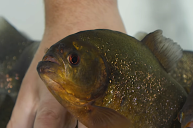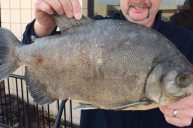A relaxed Sunday family fishing trip in Sacramento County turned into a wild experience for a 10-year-old angler when he reeled in a toothy surprise.
Jayden Fish-Kessler was casting into Dry Creek, a waterway just north of Antelope, California, when he felt a tug on the end of his line. He reeled in the fish, and at first thought he caught a giant blue gill.
Then he and his family noticed the teeth.
They concluded he'd caught a piranha but threw the fish back into the water before an expert could identify it (although they did snap a pic).
Patrick Foy of the California Department of Fish and Wildlife, said it is more likely that Fish-Kessler's catch was a pacu, which is a relative of the meat-eating piranha. Pacu are sometimes called the vegetarian piranha, mainly feed on plant material and not flesh or scales. They can grow much larger than piranha—up to three feet in total length and even up to near 90 pounds. Different sub-species of pacu are the red-bellied pacu, parrot pacu, black-finned pacu, and others.
Foy said pacus are often mistaken for piranhas because, yes, they both have teeth. But while piranhas' teeth are razor-sharp and designed for tearing into flesh, pacus have flatter, more human-like teeth. Pacus' diet mainly consists of fruit, seeds, and decaying plant matter, and occasionally snails and other fish.
Invasive Fish in California
Although pacu do not pose a threat to humans, they are still considered an invasive species in California and many other places.
Pacu have been caught in a handful of places throughout California throughout the years, including in Rohnert Park Lake, a Petaluma pond, and a pond in Santa Barbara County park.
Pacus are a common aquarium fish that can grow too large for captivity. Owners sometimes then release them into wild waters, but this can be detrimental for the native fish species that already exist there.
"Anytime you introduce an exotic species, it might take really well to our environment and really thrive, and when that happens, they tend to out-compete the native fisheries," Foy told a local news station. "It can disrupt that native aquatic ecosystem."
A single piranha was found in a lake at the Simi Valley Golf Course in Ventura County, California in 1998. Experts said this was an isolated incident. Neither pacu nor piranha have an established population in California, and both are considered invasive species.
If anglers reel in anything that resembles a pacu or piranha, Foy suggests they should contact their local department of fish and wildlife. He also reminds anglers that it's illegal to transport these fish alive.
"If they do have a fish that they think is a piranha, don't throw that back," Foy said. "We would want to take a look at that. They can take some very detailed, close photographs of the fish. In fact, open up the mouth and take very detailed photographs of the teeth and that would help us differentiate between a pacu and a piranha."
READ MORE: Watch: Angler Lands 100-Pound Swordfish from a Jet Ski




